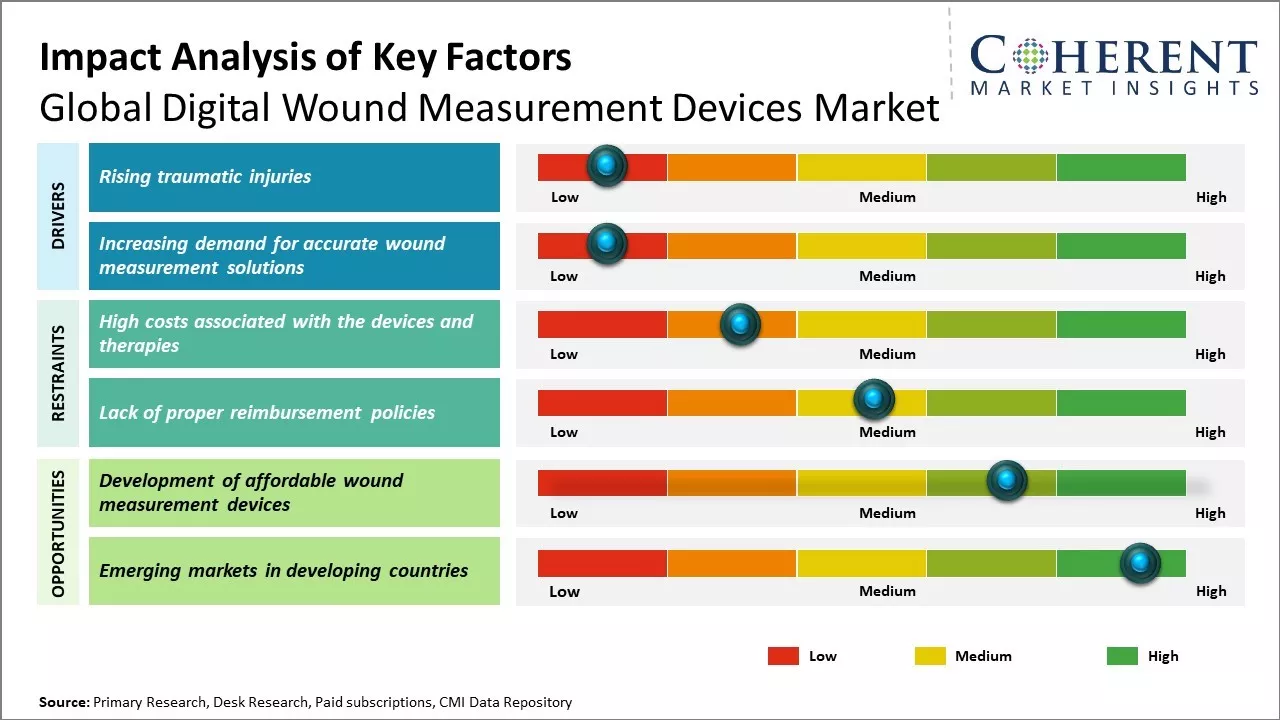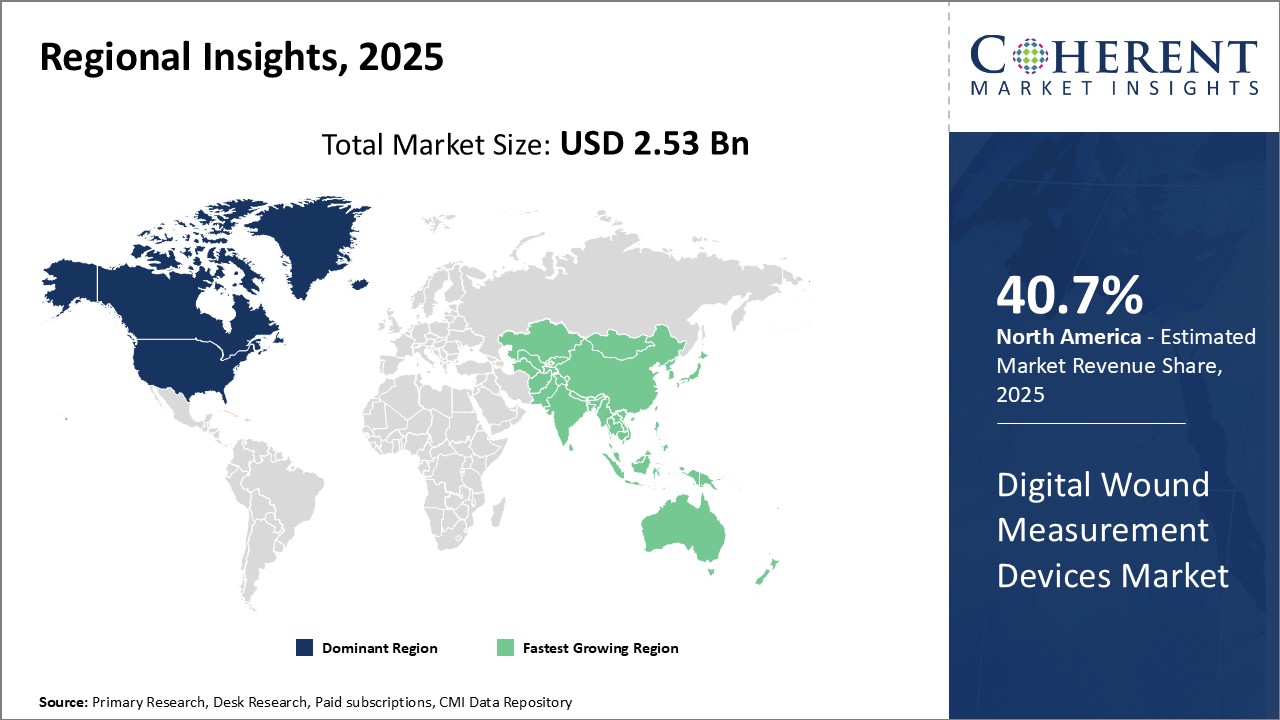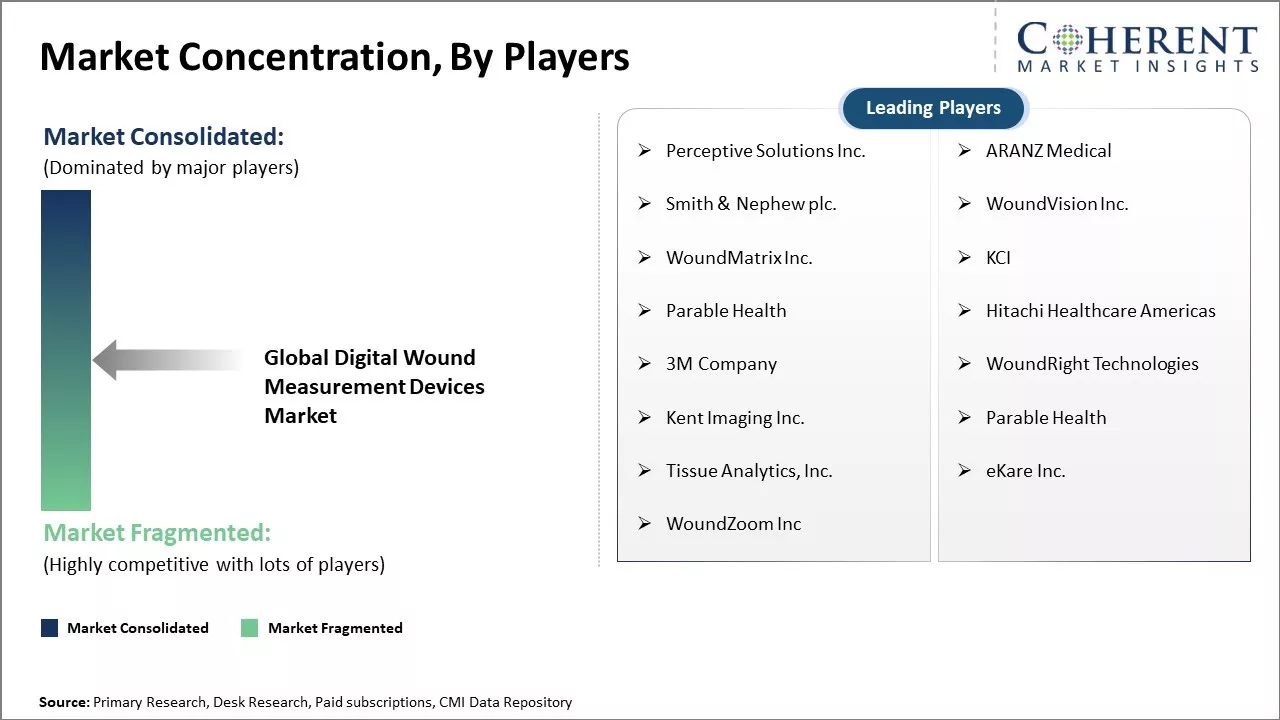Global digital wound measurement devices market share is estimated to be valued at USD 2.53 Bn in 2025 and is expected to reach USD 3.51 Bn by 2032, exhibiting a compound annual growth rate (CAGR) of 4.8% from 2025 to 2032.

To learn more about this report, Download Free Sample
Rising prevalence of diabetes and related chronic wounds, increasing adoption of advanced wound care devices, and growing need for faster healing of chronic wounds can drive the market growth. Due to increasing focus on improving healthcare outcomes, there has been huge adoption of digital wound measurement devices. These devices help in accurate measurement of wound size and shape, which helps in effective documentation of healing progress and determining the efficacy of treatment. This facilitates improved clinical decision making and management of chronic and hard-to-heal wounds. With continuous technological advancements, more efficient and user-friendly solutions are being introduced, further boosting the digital wound measurement devices market demand.
|
Current Events |
Description and its Impact |
|
Geopolitical Tensions and Trade Policy Shifts |
|
|
Healthcare Economic Dynamics |
|
Uncover macros and micros vetted on 75+ parameters: Get instant access to report
The integration of artificial intelligence into digital wound measurement device market is revolutionizing the approach towards wound assessment. AI-powered digital wound measurement devices utilize advanced algorithms to analyze wound images, automate measurements, and assist in clinical decision-making for improved wound care. These devices offer potential benefits such as increased accuracy, efficiency, and consistency in wound assessment. AI- based wound assessment tools have the potential to improve the accuracy and consistency of wound area and PGT measurement, while improving efficiency of wound care workflows.
In April 2025, Researchers at the University at Buffalo launched mmSkin, an innovative imaging system that uses radar and artificial intelligence to monitor wounds through dressings without removing bandages. The technology allows clinicians to track healing progress in real time, reducing the need for frequent dressing changes, lowering infection risks, and freeing up caregiver time.
In terms of product, contact wound measuring devices segment is estimated to contribute the highest market share of 60.3% in 2025, owing to their high accuracy in measurement. Contact devices offer direct measurement of wounds through physical contact, allowing for precise tracking of wound closure over time. As chronic and complex wounds require close monitoring to properly direct treatment, the accuracy of contact devices has increased their adoption among healthcare providers. Factors like wound depth, perimeter, and surface area measured by contact devices provide valuable insights into a wound's healing progress or deterioration. This helps clinicians make well-informed decisions about changing or optimizing a patient's treatment regimen.
Contact devices are especially useful for hard-to-measure wounds in areas like the foot, ankle, or areas with irregular wound borders. Their ability to generate reliable wound dimension data boosts confidence in treatment effectiveness and facilitates inter-professional communication about wound status. The accuracy needs of chronic and complex wounds have spurred manufacturers to continue refining contact device technologies. Advances like 3D scanning capabilities and augmented reality features incorporated into some devices allow for highly accurate 3D mapping and volumetric analyses of wounds. This level of precision measurement data assists in wound assessment and developing personalized wound therapies.
In terms of wound type, chronic wounds segment is estimated to contribute the highest market share of 30.6% in 2025. Chronic wounds like pressure ulcers and diabetic foot ulcers account for the majority of wound cases globally due to rising rates of associated chronic diseases and an aging population. An estimated 1 in 10 people over 60 years suffer from a chronic wound. Trends like increasing life expectancies, sedentary lifestyles and rates of obesity have amplified chronic disease burdens in many regions. Conditions causing impaired blood circulation or neuropathy put folks at constant risk of wounds developing and failing to heal naturally. As such diseases continue growing problems, chronic wound caseloads will steadily climb without effective management strategies. Digital wound measurement devices play a valuable role in chronic wound treatment by enabling objective tracking of wounds' responses to therapies. Their use helps optimize long-term treatment plans tailored for complex chronic wound cases. This need for evidence-based chronic wound management boosts demand for these devices.
In May 2025, iCares launched a smart bandage which is being tested on 20 human patients with chronic wounds, marking a major milestone in real‑time wound monitoring technology. It is developed by Caltech and USC researchers, the biocompatible microfluidic patch continuously samples wound fluid to track inflammation, infection, and healing biomarkers, nitric oxide, hydrogen peroxide, oxygen, pH, and temperature and detects issues in 1–3 days before symptoms appear. This intervention offers better healing outcomes.
In terms of end user, hospitals & clinics segment is estimated to contribute the highest market share of 50.6% in 2025 as hospitals treat most severe and complex wound cases. Resource-intensive wounds often necessitating inpatient care concentrate hospital demand for digital measurement devices. Hospitals house multidisciplinary wound care teams including physicians, nurses, and therapists needing visualization tools in treatment planning and documentation. Devices integrated within electronic health records further increase hospitals' tool adoption. Their purchase power and capital equipment budgets also facilitate acquiring the latest wound assessment technologies. Device data collected during hospital visits helps coordinate care as patients transition to other settings. Hospitals serve as referral hubs, so devices prescribed to high-risk cases spreading use to post-acute facilities. Staff training on devices occurs primarily in hospitals as well.
For instance, in the UK, a £250,000 fund launched by Healthy.io in late 2024 supports community nursing teams in adopting digital wound management tools, covering deployment, training, and setup, lowering implementation costs by over one-third.

To learn more about this report, Download Free Sample
North America dominates the global digital wound measurement devices market with an estimated market share of 40.2 % in 2025 due to presence of major players in countries like the U.S. Companies such as WoundZoom, Aranz, and WoundMatrix have established themselves as leaders and control a significant portion of the market through their technological advancements and wide distribution networks across the region. Supportive regulatory guidelines and reimbursement policies have ensured higher adoption rates of digital wound care solutions as compared to other areas of the world.
In April 2025, the American Professional Wound Care Association (APWCA) urged immediate industry action as Medicare’s forthcoming Local Coverage Determination (LCD) for skin substitute grafts and CAMPs takes effect. APWCA warns the policy’s rigid cap of eight applications per 16-week episode, regardless of clinical need, risks poor patient outcomes, including higher amputation and hospitalization rates and restricts provider autonomy.
Asia Pacific region emerges as the fastest growing market for digital wound measurement devices. Countries like China, India, and Japan are witnessing higher volume of chronic wounds and diabetic foot ulcers owing to their burgeoning geriatric population and changing lifestyles leading to rise in non-communicable diseases. This has propelled the demand for advanced wound care management solutions. Increasing medical expenditures and improving access to healthcare can drive the regional market growth. Moreover, presence of prominent regional MedTech companies and their focus towards development of affordable digital wound assessment platforms is positively impacting the market expansion. For instance, WoundZoom established local manufacturing units to cater to the Asian markets and gain a larger market share through competitive pricing and robust supply chain capabilities.
The U.S. digital wound measurement devices market is characterized by partnership of key market players to accelerate the data driven for wound care in the U.S. clinics. For Instance, in May 2025, partnership between Omeza and Advanced Solution, a provider of medical technologies, poised to reshape outpatient wound care across the United States. By combining Omeza’s biologically active topical therapies with Advanced Solution’s smart, integrated measurement systems, the collaboration aims to deliver novel, data-driven treatment protocols for chronic and complex wounds. Additionally, U.S. is experiencing rapid commercialization which helps in keeping track of healing progress in real-time, enhancing both clinical efficiency and patient outcomes. Along with that the standardization of wound care protocols ensures consistent documentation and evidence-based care at scale. This is further propelling the digital wound measurement devices market growth.
China is exhibiting significant growth in digital wound measurement devices market through a growing economy, advancements in the healthcare system, and increasing awareness of advanced wound care products. The country is witnessing growth in the wound care market, driven by customer preferences for high-quality and advanced products, the adoption of specialized treatments for chronic wounds, and the establishment of specialized wound care units in hospitals.
For instance, a World Diabetes Foundation‑backed initiative, WDF09‑0467, has successfully trained Chinese healthcare professionals in diabetic foot and chronic wound care across five provincial hospitals, per the Chinese Tissue Repair Society. Over 60 workshops educated 9,229 clinicians, establishing 42 wound‑care teams. As a result, 9,092 diabetes patients were screened and 4,900 benefitted, while 1,209 potential amputations were averted, and ongoing professional development continues post‑completion.

To learn more about this report, Download Free Sample
| Report Coverage | Details | ||
|---|---|---|---|
| Base Year: | 2024 | Market Size in 2025: | USD 2.53 Bn |
| Historical Data for: | 2020 To 2024 | Forecast Period: | 2025 To 2032 |
| Forecast Period 2025 to 2032 CAGR: | 4.8% | 2032 Value Projection: | USD 3.51 Bn |
| Geographies covered: |
|
||
| Segments covered: |
|
||
| Companies covered: |
Perceptive Solutions Inc., ARANZ Medical, Smith & Nephew plc., WoundVision Inc., WoundMatrix Inc., KCI, Parable Health, Hitachi Healthcare Americas, 3M Company, WoundRight Technologies, Kent Imaging Inc., Parable Health, Tissue Analytics, Inc., eKare Inc., WoundZoom Inc |
||
| Growth Drivers: |
|
||
| Restraints & Challenges: |
|
||
Uncover macros and micros vetted on 75+ parameters: Get instant access to report
Rising traumatic injuries from incidents like road accidents, workplace mishaps, sports injuries, and violence can drive the global digital wound measurement devices market growth. These devices play a crucial role in healthcare by providing accurate measurements of wound size using technologies such as planimetry, 3D scanning, and cameras. This capability aids healthcare providers in effectively monitoring wounds across different stages of healing, facilitating proper documentation, treatment decisions, and longitudinal comparisons. There has been huge demand for these devices due to rising incidence of road accidents, which is predicted to be the major cause of death by 2030 as per WHO, Aging population, prone to chronic and difficult-to-heal wounds, can drive the market growth. The limitations of traditional measurement methods and human eye assessments further underscore the need for reliable digital tools in wound management. Rising traumatic injuries and the healthcare sector's shift towards advanced solutions can boost demand for digital wound measurement devices.
For instance, according to updated data from John Hopkins University in January 2023, more than 30 million children and teenagers participated in organized sports in the U.S., with over 3.5 million experiencing traumatic injuries. According to the data published by the Journal of Orthopaedic Research in December 2022, the National Electronic Injury Surveillance System recorded 4,666,491 bicycle-related injuries in the U.S.
Increasing demand for precise wound measurement solutions can drive the market growth. Healthcare providers are shifting towards advanced treatment approaches that emphasize accurate documentation and monitoring of wound progress, necessitating tools capable of precise measurements of size, depth, geometry, and volume over time. Traditional analogue methods like rulers and measuring tapes are perceived as inadequate for providing the consistency and accuracy required for clinical decision-making and reimbursement purposes. Basic digital tools such as smartphone apps or simple cameras, which offer approximate measurements, are also falling out of favor as providers prioritize more accurate solutions. Devices utilizing 3D imaging, planimetry, or laser-based technologies are now considered essential for meeting stringent accuracy requirements. However, these advanced solutions often come with higher costs due to their sophisticated hardware, training needs, and data processing requirements. This cost barrier presents challenges for adoption in cash-strapped healthcare facilities, particularly in developing countries, limiting the penetration of digital wound measurement devices in these settings. Digital wound measurement devices market research highlights this gap, pointing to the need for cost-effective innovations to broaden access globally.
The development of affordable wound measurement devices can offer opportunity for global digital wound measurement devices market growth. Accurate and affordable wound measurement plays a vital role in effective wound management and care. Many clinics and hospitals in developing countries lack access to reliable and cost-effective digital wound measurement tools. This negatively impacts wound healing outcomes and increases financial burden on patients. Providing low-cost digital wound measurement solutions can address this issue. Affordable devices with features like optical or 3D scanning would allow for regular and precise evaluation of wound closure over time under the supervision of local healthcare workers. This is important because most chronic wounds in low- and middle-income nations are controllable but often go untreated due to lack of resources. Reliable data on wound progress can help optimize treatment plans and ensure wounded individuals receive proper follow-up. It can also prevent minor wounds from developing into more serious infections or complications. As per digital wound measurement devices market forecast reports, expanding access to affordable solutions in emerging economies is expected to significantly influence overall market expansion.
Share
Share
About Author
Manisha Vibhute is a consultant with over 5 years of experience in market research and consulting. With a strong understanding of market dynamics, Manisha assists clients in developing effective market access strategies. She helps medical device companies navigate pricing, reimbursement, and regulatory pathways to ensure successful product launches.
Missing comfort of reading report in your local language? Find your preferred language :
Transform your Strategy with Exclusive Trending Reports :
Frequently Asked Questions
Joining thousands of companies around the world committed to making the Excellent Business Solutions.
View All Our Clients